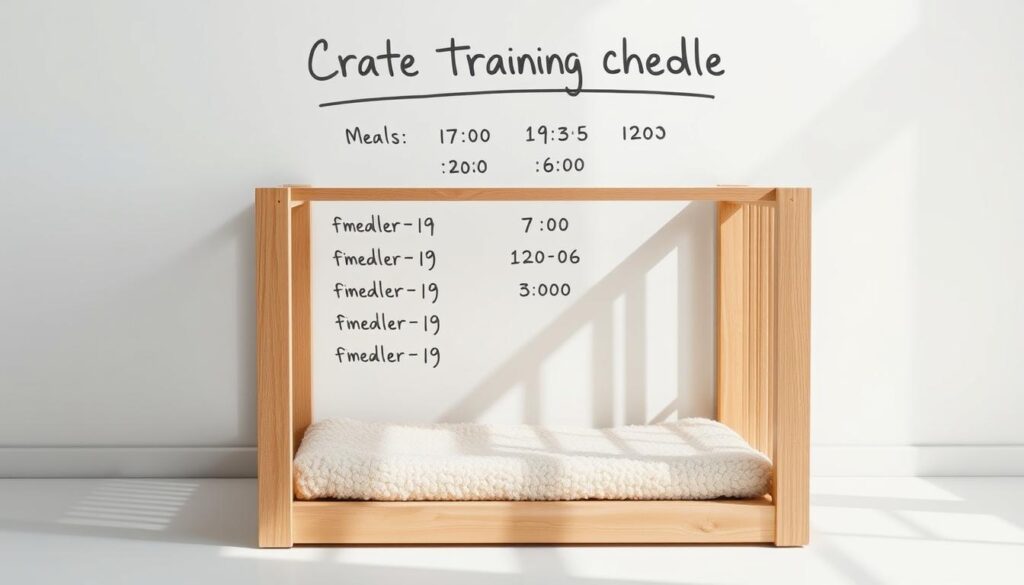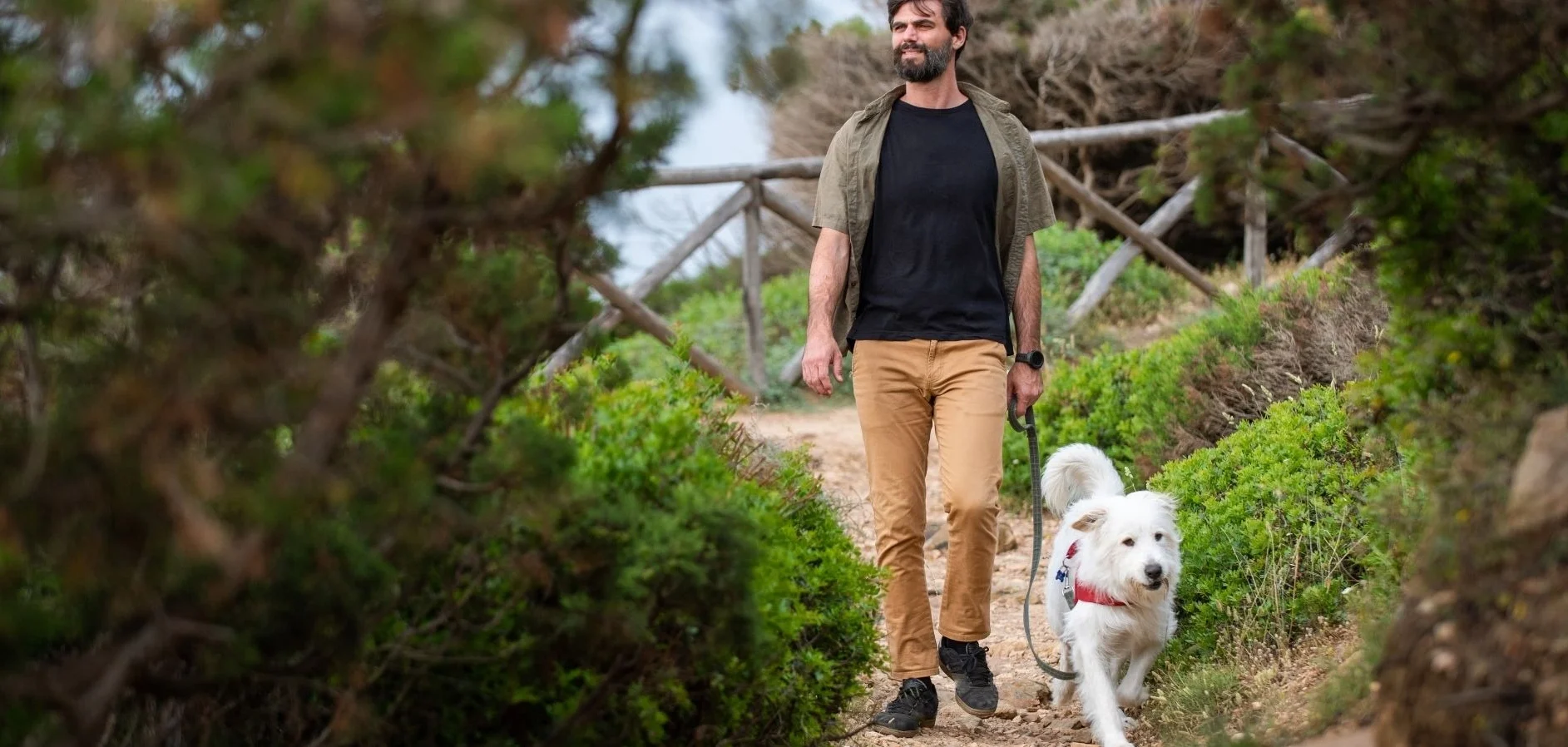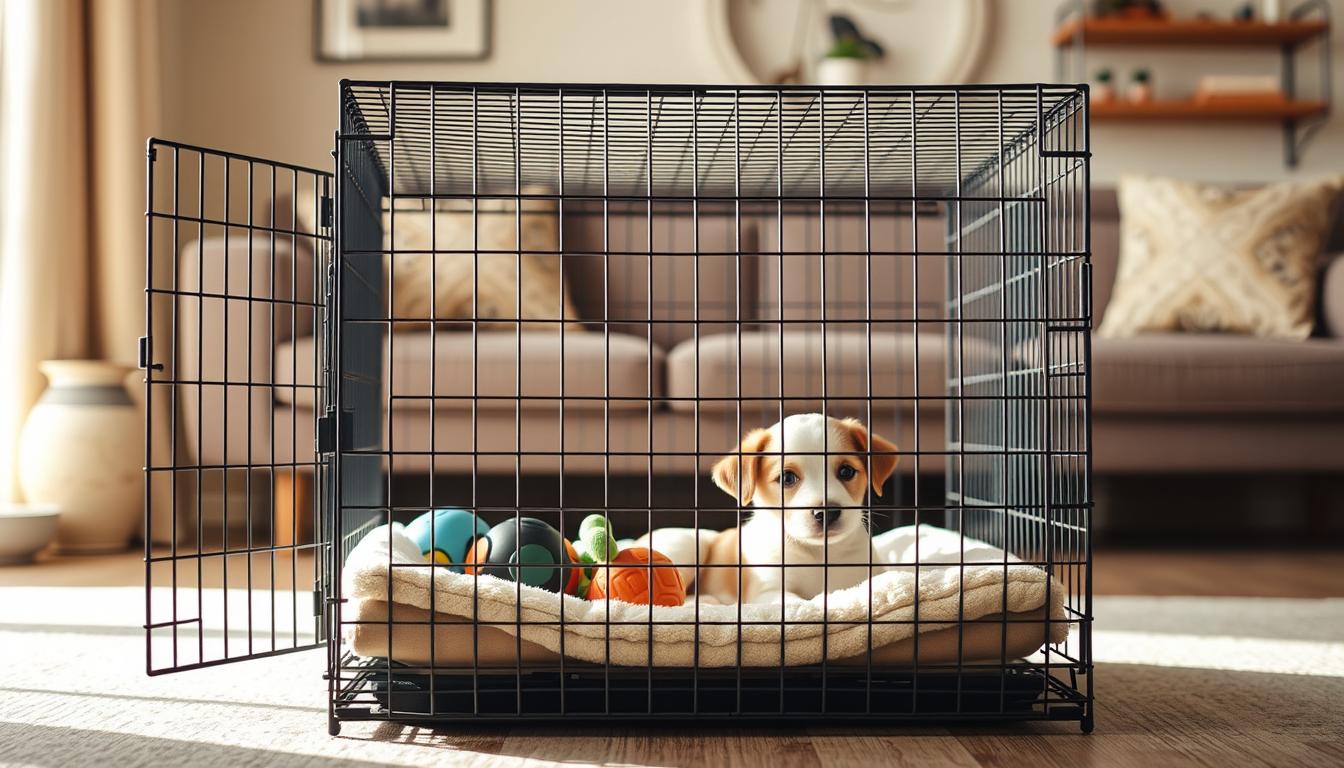Crate Training a Puppy: Make Your Pup Feel Safe and Loved
Table of Contents
Bringing home a new puppy is an adventure filled with joy, love, and a few challenges. When I first welcomed my Golden Retriever puppy, I quickly realized that puppy crate training wasn’t just a training technique—it was a pathway to creating a secure, happy relationship with my furry companion.
Crate training a puppy is more than just containment. It’s about providing a safe, comfortable space that meets your puppy’s natural instincts while helping you establish essential boundaries and routines. This comprehensive guide will walk you through everything you need to know about effective puppy crate training.
Whether you’re a first-time dog owner or looking to refine your training skills, understanding the fundamentals of crate training can transform your puppy’s development and your shared living experience. We’ll explore how this method supports your puppy’s emotional and physical well-being.
Key Takeaways
- Crate training leverages natural canine den instincts
- Creates a safe, personal space for your puppy
- Supports house training and behavior management
- Reduces anxiety and provides security
- Helps establish consistent routines
Understanding the Importance of Crate Training
Crate training for dogs is a powerful method that taps into your puppy’s natural instincts. It offers many benefits for both you and your furry friend. When done correctly, it becomes an essential skill that creates a safe, comfortable environment for your new companion.
Dogs have an innate desire for a secure, den-like space. This evolutionary trait makes crate training an effective approach. It helps your puppy feel protected and calm. Understanding these natural instincts is crucial when learning how to crate train a puppy.
Natural Den Instincts in Dogs
Wild canines have always sought out small, enclosed spaces for safety and comfort. Your domesticated puppy carries these same instincts. A crate becomes an ideal personal sanctuary for them. This natural tendency helps explain why crate training for dogs can be so successful.
Benefits for Both Puppies and Owners
- Provides a safe personal space for your puppy
- Assists in effective house training
- Prevents destructive behaviors
- Reduces anxiety during travel
- Creates a consistent routine
Safety and Security Aspects
Crate training offers multiple safety advantages for your puppy. It protects them from potential household dangers when you cannot directly supervise. It also provides a secure environment during stressful situations.
| Crate Training Aspect | Safety Benefit |
|---|---|
| Supervised Confinement | Prevents accidents and destructive behavior |
| Personal Safe Space | Reduces stress and anxiety |
| Travel Protection | Keeps puppy secure during transportation |
By understanding these critical aspects of crate training, you’ll be well-prepared. You’ll create a positive, nurturing environment for your new puppy.
Selecting the Right Crate for Your Puppy
Choosing the right crate is key for puppy training. It affects your puppy’s comfort, safety, and training. Different crates have special benefits for your puppy.
When picking a crate, think about these important things:
- Puppy’s projected adult size
- Material durability
- Ease of cleaning
- Portability requirements
Measure your puppy and guess their adult size. A crate that’s too small or too big is not good. It should feel like a cozy den to your puppy.
Different materials in crates have their own pluses:
| Crate Type | Pros | Cons |
|---|---|---|
| Plastic | Lightweight, travel-friendly | Less ventilation |
| Wire | Excellent airflow, adjustable | Can be heavy |
| Fabric | Portable, lightweight | Less durable |
Pro tip: Choose a crate with a divider panel. It grows with your puppy, saving you from buying new crates often.
Essential Crate Training Equipment and Setup
Getting your puppy’s crate ready for training needs careful thought and the right gear. You want to make a cozy, welcoming spot for your puppy. This will help them feel safe and happy.
To start a good crate training schedule, pick the right stuff and place it right. Your puppy’s crate should be a cozy spot that feels like home.
Proper Crate Size and Positioning
Finding the perfect crate size is key for good training. Think about these important points:
- Choose a crate where your puppy can stand, turn, and lie down easily
- Get a crate with a divider for growing puppies
- Put the crate in a quiet spot, but still easy to get to
Comfort Items and Accessories
Make the crate a cozy place with these must-haves:
- Soft, easy-to-clean bedding
- Safe chew toys
- A cozy blanket with a familiar scent
- A water-resistant bottom liner
Creating a Welcoming Environment
Turn the crate into a happy spot by:
- Adding familiar scents from home
- Keeping it calm and quiet
- Using treats to make it a positive place
Remember, patience and consistency are key in developing a successful crate training schedule for your puppy.
Crate Training a Puppy: The Foundation Process
Learning to crate train a puppy starts with understanding the basics. It’s a process that needs patience, consistency, and a smart plan. This helps your puppy feel safe and happy.
First, introduce your puppy to the crate slowly. Put it in a place where your puppy can see and play with it. Add soft blankets and fun toys to make it inviting.
- Begin with short, positive crate experiences
- Use treats to create positive associations
- Never force your puppy into the crate
- Keep initial sessions brief and enjoyable
For crate training to work, make the crate a cozy den. Your puppy should see it as a safe place, not a punishment.
| Training Stage | Duration | Goal |
|---|---|---|
| Initial Introduction | 5-10 minutes | Create positive crate association |
| Short Confinement | 15-30 minutes | Build puppy’s comfort level |
| Gradual Increase | 1-2 hours | Develop crate tolerance |
Every puppy is different. Be patient and keep your training consistent. Celebrate small wins and never scold your puppy for feeling anxious about the crate.
Establishing a Positive Crate Association
Puppy crate training is about making a safe and welcoming space. It’s about turning the crate into a cozy spot your puppy will enjoy. This is key to successful crate training.
Using Treats and Rewards
Positive reinforcement is key in puppy crate training. The way you reward your puppy greatly affects their crate experience. Here are some tips:
- Choose high-value treats your puppy loves
- Give treats only when they calmly enter or stay in the crate
- Use soft, special treats that take time to eat
Creating Positive Experiences
Make crate time fun for your puppy. Good crate training tips can turn it into a cozy retreat.
| Activity | Benefit |
|---|---|
| Feed meals in crate | Links crate to positive mealtime |
| Place favorite toys inside | Encourages them to go in on their own |
| Practice short, fun sessions | Helps them feel comfortable and less anxious |
Building Trust and Confidence
Being patient and consistent is crucial in crate training. Never use the crate as punishment. Instead, make it a safe place where your puppy feels safe and relaxed.
- Speak softly and positively near the crate
- Let them explore it on their own
- Slowly increase the time they spend in it
Developing a Consistent Training Schedule

Creating a structured crate training schedule is key for successful puppy training. It helps your puppy know what to expect and lowers anxiety. Puppies love routine, making a consistent schedule vital for crate training.
A good crate training schedule includes:
- Feeding times
- Potty breaks
- Playtime
- Rest periods
- Overnight sleeping
Young puppies need more breaks and shorter crate times. As they grow, you can make crate time longer and adjust the schedule.
| Puppy Age | Crate Sessions | Typical Duration |
|---|---|---|
| 8-10 weeks | Short, frequent | 15-30 minutes |
| 10-16 weeks | Moderate | 30-60 minutes |
| 4-6 months | Extended | 1-2 hours |
Pro tip: Always watch your puppy’s comfort and adjust the schedule as needed. Being patient and consistent is crucial for crate training.
“A structured routine builds confidence and helps your puppy feel secure in their new environment.”
Nighttime Crate Training Strategies
Nighttime crate training can be tough for puppies and owners. It needs patience, consistency, and a smart plan. This helps your puppy feel safe and comfy at night.
The first nights are key to a good sleep routine. Your crate training guide should make the crate a calm, safe spot for your puppy.
Managing First Nights
Start by putting the crate near your bed. This makes your puppy feel close and less scared. Here are some tips:
- Place a comfy blanket in the crate
- Use a soft toy for comfort
- Keep the crate in a quiet, dimly lit area
Dealing with Whining
Puppies might whine at first. It’s important to know how to handle it:
- Figure out if they’re seeking attention or really need something
- Don’t rush to every whimper
- Take them out for a quick potty break if needed
Establishing Sleep Routines
Consistent routines help puppies get used to sleeping in the crate. Move the crate to its final spot slowly. Keep a regular bedtime schedule.
| Age | Recommended Crate Time | Potty Break Frequency |
|---|---|---|
| 8-10 weeks | 2-3 hours | Every 2 hours |
| 11-14 weeks | 3-4 hours | Every 3-4 hours |
| 15-16 weeks | 4-5 hours | Every 4-5 hours |
Remember, every puppy is different. Tailor these tips to fit your situation and stay patient during crate training.
Common Crate Training Challenges and Solutions

Crate training a puppy can be tough. It’s important to know how to handle problems and use positive methods to solve them.
Puppies might feel anxious when they start crate training. It’s key to spot and fix any behavioral issues that come up.
- Whining and Crying: This is a big problem for many owners. Your puppy might cry because they’re uncomfortable or want attention.
- Resistance to Entering: Some puppies might be scared or hesitant to go into their crate.
- Escape Attempts: Energetic puppies might try to get out of their crate.
There are ways to overcome these issues. Begin by making the crate a good place with treats and praise.
| Challenge | Solution |
|---|---|
| Excessive Whining | Ignore vocalization, reward quiet behavior |
| Crate Resistance | Use high-value treats, create positive associations |
| Separation Anxiety | Gradual alone time, calming techniques |
Every puppy is different. Being patient and consistent is key. If you’re still having trouble, get help from a professional dog trainer.
Transitioning to Longer Crating Periods
As your puppy grows, crate training gets more complex. It’s important to increase crate time slowly and carefully. Young puppies need short times, while older dogs can handle longer periods.
Understanding your puppy’s needs and comfort is key. Begin with short times and gradually increase it. This helps your puppy get used to being in the crate.
- Puppies under 4 months: 1-2 hours maximum
- Puppies 4-6 months: 2-4 hours maximum
- Puppies 6-12 months: 4-6 hours maximum
Look for signs your puppy is ready for longer crate times:
- Calm behavior when entering the crate
- No excessive whining or distress
- Comfortable sleeping through the night
Make sure to balance crate time with plenty of exercise, mental stimulation, and interaction. Your puppy needs to stay active and engaged to stay healthy and happy.
| Age Range | Recommended Crate Time | Exercise Needs |
|---|---|---|
| 8-16 weeks | 1-2 hours | High |
| 4-6 months | 2-4 hours | Moderate |
| 6-12 months | 4-6 hours | Moderate to Low |
Every puppy is different. Adjust your crate training schedule to fit your dog’s unique needs and growth.
Conclusion
Crate training a puppy is a journey that shapes your dog’s behavior and comfort. It creates a safe space for your puppy’s growth. This journey needs dedication, patience, and positive reinforcement.
Being committed to crate training brings many benefits. A well-trained dog views the crate as a safe haven, not a punishment. Each success builds trust and communication with your puppy. Remember, every dog is unique, so tailor your training to fit your puppy’s personality.
Keep reinforcing the positive aspects of the crate as your puppy grows. Stick to the training methods you’ve learned and adjust as needed. Crate training is a continuous journey of understanding and bonding with your dog.
Approach crate training with an open heart and consistent effort. Your patience will lead to a confident, well-adjusted dog. They will see their crate as a safe and comfortable space.
FAQ
At what age can I start crate training my puppy?
You can start crate training your puppy as early as 8 weeks old. At this age, they are ready to learn and adapt. Start with short, positive sessions and increase the time as they get more comfortable.
How long can a puppy stay in a crate during the day?
Puppies can hold their bladder for about one hour per month of age. For young puppies, crate time should be 2-3 hours a day. Never more than 4 hours for puppies under 6 months. Make sure they get exercise, potty breaks, and interaction outside the crate.
Is crate training cruel or harmful to my puppy?
Crate training is not cruel when done right. It uses a dog’s natural den instincts for a safe space. Make the crate positive, never punish, and give lots of love and exercise outside.
How do I stop my puppy from crying in the crate?
Make the crate positive with treats, comfy bedding, and toys. Increase crate time slowly and ignore every whimper. Ensure they’re comfortable, exercised, and have gone to the bathroom before crate time.
What size crate should I buy for my puppy?
Choose a crate where your puppy can stand, turn, and lie down. Use divider panels for growing puppies. Measure your puppy and estimate their adult size for a long-term crate.
Can I use the crate for punishment?
No, never use the crate as punishment. It should be a safe, positive space. Punishment can make crate training hard and stressful for both you and your puppy.
How long does crate training typically take?
Crate training time varies by puppy. Most puppies get comfortable in 1-2 months. Be consistent, patient, and positive for success. Some puppies adapt quickly, others take longer.
Should I cover the crate with a blanket?
Covering the crate can be comforting for puppies. But, check for proper ventilation and your puppy’s comfort. Use a breathable cover and remove it if they seem uncomfortable.
How do I crate train a puppy at night?
Start with the crate near your bed for security. Have a consistent bedtime routine and ensure a final potty break. Use comfy bedding and expect some whining. Gradually move the crate to its spot as they get more comfortable.
Can older dogs be crate trained?
Yes, older dogs can be crate trained, but it takes more time and patience. Use positive reinforcement and make the crate appealing. Older dogs may need extra time and a gentle approach due to ingrained habits.
There are no reviews yet. Be the first one to write one.


